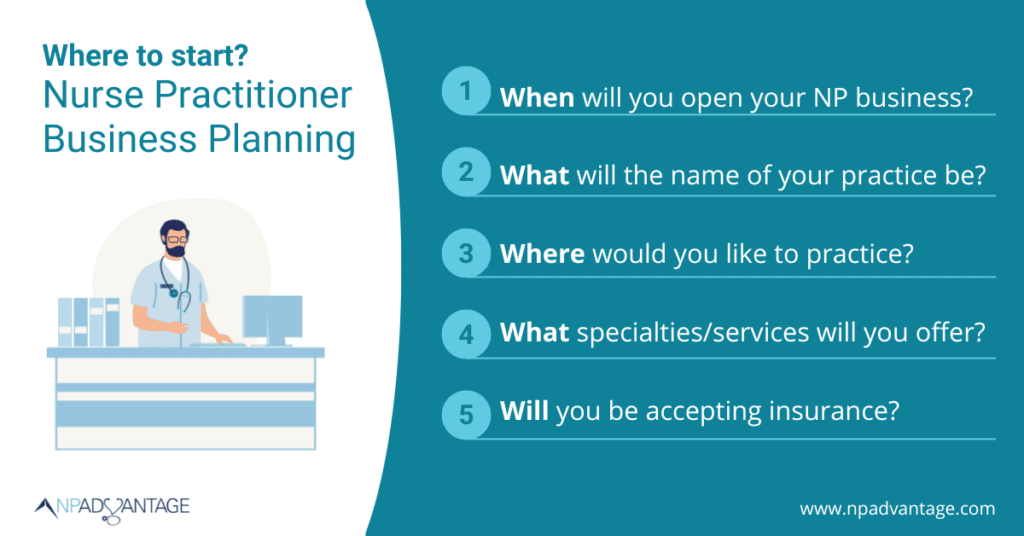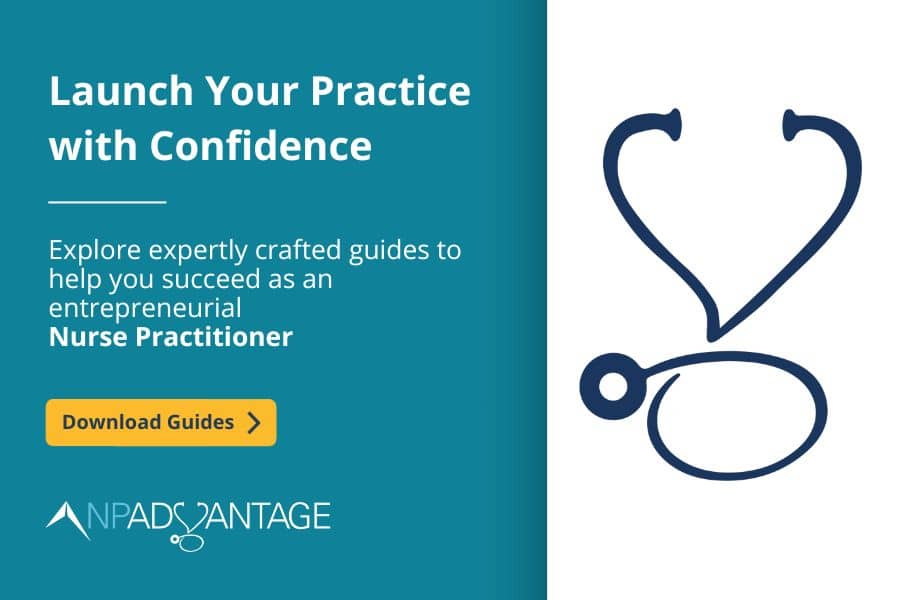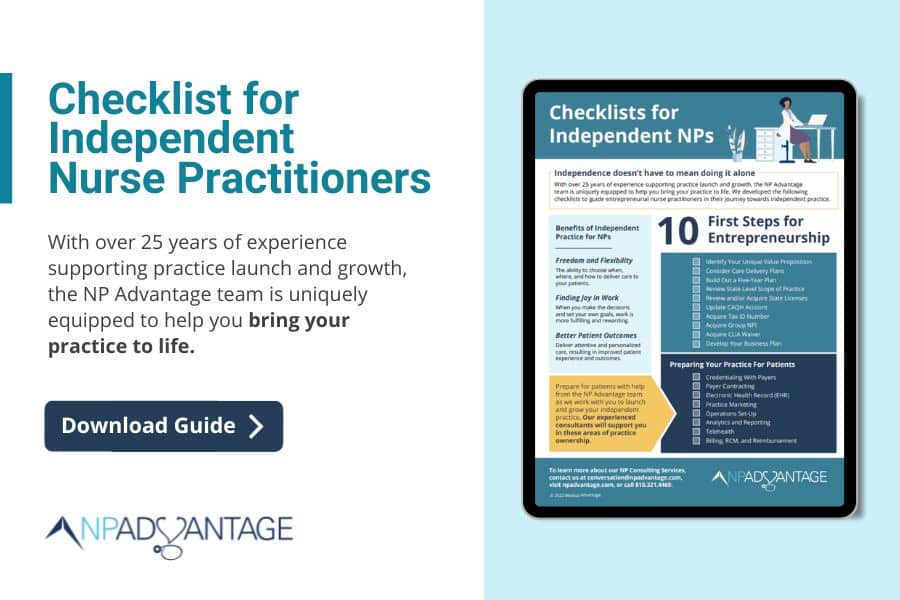As you begin to pursue your goal of becoming a nurse practitioner business owner, start by gathering the many thoughts and ideas that you may have. This will be the foundation of your nurse practitioner business plan.
An NP business plan will be essential to guiding you along this journey, as well as informing any other partners, colleagues, or investors you plan to work with about your strategy and goals.
With many nurse practitioner entrepreneurs often lacking traditional business education or entrepreneurial experience, it is often beneficial to reflect on questions like:
- How do I become a nurse entrepreneur?
- How do I pursue my nurse practitioner business ideas?
- How do I write a business plan for my NP practice?
Nurse Practitioner Business Planning: Where to start?
The first step in becoming a nurse entrepreneur is a business plan. Your business plan can start with anything from a name for your NP-owned business, to the payers you’d like to accept, to the patients you’d like to see. These ideas can form the basis of and guidance for a nurse practitioner business model. Some important components to consider are:
- When would you like to open your NP business?
- What will you name your independent practice?
- In what states would you like to practice?
- Where can nurse practitioners practice independently?
- Will your nurse practitioner business be brick-and-mortar? Telehealth? Home visit?
- What specialties/services will you offer? Is there a need for that in the community you’re serving?
- Will you be accepting insurance? Which payers?
- What steps can you take to grow your practice?
- Will you start full-time? If not, when will you make the transition to full-time?

8 Components of a Nurse Practitioner Business Plan
Now that you have documented your nurse practitioner business ideas, it is time to begin organizing them into a business plan that demonstrates your vision and will guide your NP business model and strategy.
1. An Executive Summary
The executive summary is a concise summary of the details in the following sections. It should describe your practice and its purpose. This is an opportunity to demonstrate your passion and vision – and should summarize all key points in one section – as it is the first impression for your business plan, and potentially the only portion an executive will review if they’re tight on time.
Share why you want to be a nurse practitioner business owner, and the value you’ll bring to the market and your community. The goal is to generate interest in anyone who may be considering supporting your business. Picture yourself as a potential partner, colleague, or investor – have you been presented with a plan that you’d want to be a part of?
Though this section will be presented first in your finalized NP business plan, it often is written last, once the rest of the plan is complete in detail, so that you can provide an accurate and succinct executive summary.
2. Company Overview
The company overview will dive deeper into your nurse practitioner business model, providing a more detailed description of the nurse-owned practice you plan to launch. If helpful, you can follow the five W’s that you may remember from grade school.
Who – There are several elements to this. First, it is a description of who you are as a business, including specialties and the unique value your practice will bring to the community.
Second, provide background on who you are as a prospective nurse practitioner business owner. How long have you been a nurse practitioner? What was your experience before that? How will these experiences help you as a nurse entrepreneur?
Lastly, who will you be serving? What will your patient panel look like?
What – Provide a brief overview of the services your nurse practitioner private practice will be providing to patients (a more in-depth version of this will be developed in the next section). In this stage you should identify your specialty – be it primary care, family practice, gerontology, women’s health, psychiatrics, or something else.
Additionally, provide clarity as to how patients will access your services – i.e., whether you plan to have a brick-and-mortar NP business or provide only telehealth services. Whatever your care delivery plans are, make sure they’re clearly outlined here.
Where – Where do you plan to open your practice? Will you only see patients in your local area, or will you use telehealth to see patients across state lines? Identify the areas you plan to serve and provide an overview of any expansion plans you may have in the future.
These decisions should take both patient volume and the number of competitors into consideration. Remember, if you’re licensed in multiple states, it may be worthwhile to include those states in your nurse practitioner business model.
When – Establish a desired opening date for your NP private practice, a timeline for activities leading up to your launch, and any planned post-launch activities.
Be sure to consider the time it will take for processes like credentialing, payer contracting, EHR set-up, and website development. This will help ensure that your target opening date leaves adequate time for the completion of these tasks and more.
You also should consider providing a five-year plan for your practice that includes items like expected patient volumes, when you will transition to full-time, and when and how you plan to hire additional providers or staff as your practice grows.
Why – Why do you want to pursue nurse practitioner entrepreneurship? And why should a patient select you as their provider? These are essential questions for you and any other relevant parties to understand.
Many aspiring NPs have nurse practitioner business ideas that were inspired by gaps they identified in the healthcare system. If that’s the case, explain those gaps and how you intend to address them. Making the switch from employment in the system to NP private practice is a big leap – why do you want to be a nurse practitioner business owner?
3. Products and Services
In this section, provide a clear description of the healthcare services you intend to offer, including what the services are, how much they’ll cost, and what you’d expect to earn for each service.
Because the services themselves are typically going to be rather similar across different providers, you’ll want to highlight anything that gives your nurse practitioner business a competitive advantage against others in your specialty.
For instance, if you participated in a specific hypertension management study, were published for your insights on care management, or were highly regarded as a talented Psychiatric-Mental Health Nurse Practitioner (PMHNP) in a former role, be sure to highlight those accolades and experiences to demonstrate your value.
4. Market Analysis
This section is an opportunity to demonstrate your healthcare industry knowledge from your unique point of view as a nurse practitioner entrepreneur. Identify key patient segments you wish to target, an explanation of your experience, and a detailed analysis of relevant data. This will create a thoughtful summary of why you believe this is the right market to enter.
Consider things like patient volume and demographics, along with an analysis of providers in your area offering similar services. Ideal situations include large populations in your target segments and low competition – though your NP private practice can thrive under more challenging conditions with the support of an NP business consultant.
5. Strategy & Implementation
This section is all about clearly explaining your nurse practitioner business model as well as your strategy for market entry and growth. It also is another opportunity to highlight your unique vision for your NP business.
Provide a more detailed explanation of your service delivery methods – such as brick-and-mortar or telehealth. For example, provide an explanation of how you intend to leverage these delivery methods and why they are the best option for your nurse-owned business. Also include details on potential facilities you have planned, as well as your planned hours of operation.
Remember, as you discuss your business plan with people like your local Small Business Development Center or potential investors, they likely will not know your healthcare background. Don’t be afraid to stand by your decisions – but be ready to provide detailed explanations as to why your strategy will resonate with patients.
6. Marketing Strategy
Marketing your new NP private practice will be critical to spreading the word about your offerings, building your patient panel, and staying engaged with your community. Develop a detailed NP practice marketing plan that outlines how you intend to reach new patients.
In today’s digital age, you’ll need a practice website designed to demonstrate your unique value with a focus on patient education, engagement, and acquisition. This website should be backed by a strong search engine optimization (SEO) strategy to help you improve your search engine rankings. You also may consider social media, digital advertising, and online reputation management as additional digital marketing strategies for your NP business.
7. Organization & Management
Typically, this section would outline the full company hierarchy, including all management teams and employees. However, as a nurse practitioner entrepreneur, you’ll likely be one of only a few employees, if not the only employee, in your private practice.
In your NP business scenario, this section should be more straightforward. Provide an introduction of yourself and any other colleagues or partners who will be a part of your NP private practice, including information about your roles, expertise, and experience. It also may be helpful to provide information on external parties who will be directly involved as well, such as accountants, advisory boards, or marketing personnel.
8. Financials
This section often requires the assistance of an accountant or financial advisor, though it can be completed independently depending on your level of comfort with NP private practice financials, projections, and expenses. Be sure to account for any NP business expenses you have already incurred – such as a marketing vendor who is designing your logo or a lawyer who has assisted you in navigating legal issues for nurse practitioner entrepreneurs.
In addition, document any earnings you have already generated, like cash-only patients you may have seen before your independent practice was officially live. Then prepare projected financial information like income statements, balance sheets, cash flow statements, and expense budgets for the next five years.
What to do With Your Nurse Practitioner Business Plan
Now that you’ve taken the time to document and organize your NP business ideas into a business plan for your nurse-owned practice, what’s next? The first thing you should do is review the completed business plan a few times. Check for errors in spelling or financial projections and make sure your unique vision and passion are expressed.
Next, have a friend, family member, or trusted colleague review the plan. Ask that they provide their honest feedback on your nurse practitioner business model. Do they think it is a solid plan? Do they believe that you’ve adequately differentiated yourself from similar providers? Can they feel your passion in the business plan?
If they say no to any of these questions, it is likely that potential investors or partners would agree. Work with your trusted support system to make any adjustments before presenting to external resources.
When you are ready to present your business plan to potential investors or partners, proceed with confidence. You have the experience as a provider, the passion as an NP entrepreneur, and a clear nurse practitioner business plan to back the independent practice you’ve been dreaming of. Remember, even if other parties don’t feel that your nurse-owned practice is the right fit for them, that doesn’t mean your plan can’t work.
Above all, your nurse practitioner business plan was crafted to serve you. Utilize it as a tool to guide your path forward, with or without the involvement of external parties. It serves not only as a guide to get you started, but it also is your source of truth along the journey.
Check in with your plan frequently. Is everything going as planned? What’s changed? Why? How can you improve upon your initial NP business ideas? All of these questions will be important to consider as you continue innovating your nurse practitioner business model.
NP Advantage Can Help
Having an effective NP business plan in place is an important first step to building a successful NP practice. NP Advantage’s consultants have experience meeting nurse practitioners where they are – with a solutions suite designed to fit your unique vision. We provide the tools, technology, and training to drive success for your nurse practitioner business.
Are you ready to take the next step in your journey to independence? Reach out to one of our expert consultants today to find out how a partnership with NP Advantage can turn your goals into reality.




